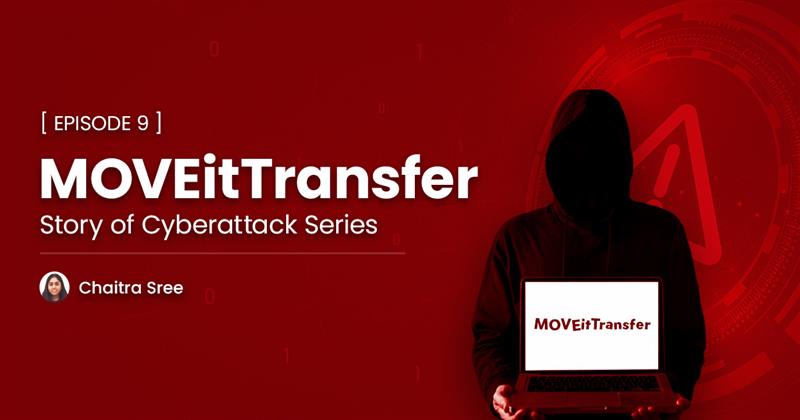In countless organizations worldwide, from bustling universities to national healthcare systems, the MOVEit Transfer tool developed by Progress Software quietly fulfills a vital mission: secure file transfer.
Built to facilitate the seamless exchange of sensitive data, MOVEit is trusted by governments, financial institutions, energy firms, and beyond. It’s robust, reliable, and was considered safe.
However, in the year 2023, things changed! In this blog, let’s dive deep and understand what exactly happened.
Unseen Vulnerability
On May 27, 2023, a silent alarm was triggered. A sophisticated threat actor discovered a zero-day SQL injection vulnerability in the internet-facing MOVEit web interface, later catalogued as CVE?2023?34362. This flaw allowed an attacker to inject malicious SQL code, bypass security controls, and plant a web shell onto the server database.
This was no ordinary vulnerability. Through the obscure injection point, an attack could:
- Install a stealth web shell
- Harvest sensitive data from MOVEit’s databases
- Create rogue administrator accounts (“Health Check Service”) to ensure persistent access.
It was a worst-case scenario: a single breach point with the potential to compromise thousands of organizations.
CL0P Strikes
Notorious for ransomware and double?extortion tactics, the hacking collective CL0P, also known as TA505, swiftly claimed responsibility.
Leveraging the zero?day, they:
- Deployed LEMURLOOT web shells on compromised MOVEit servers.
- Extracted confidential files, from personal health records and financial statements to payroll data.
- Blackmailed organizations threatened to leak stolen data on their leak site unless ransom demands were met.
While CL0P did not deploy traditional encryption payloads, the stolen data became the weapon, a prime example of double?extortion: “Pay us, or your data gets public.”
Widespread Supply?Chain Fallout
What made this attack especially devastating was its supply-chain nature. MOVEit wasn’t just used by one organization but was integral to workflows across industries and continents.
Once the vulnerability was exploited:
- Hundreds, then thousands, of organizations were hit.
- By October 2023, over 2,000 entities had been compromised, affecting an estimated 60 million individuals.
- CL0P’s ransom notes listed victims publicly, pressuring those who wished to avoid reputational damage.
The high-profile victims were the BBC, British Airways, Aer Lingus, universities like those in the Colorado State University System, and energy giants such as SLB.
This ripple effect illustrated how a single vulnerability in a widely used IT tool could become a global crisis overnight.
Patches and Alerts
When the incident surfaced, Progress Software acted quickly:
- On May 31, they released patches addressing CVE?2023?34362.
- Subsequent vulnerabilities (CVE?2023?35036 on June?9, and CVE?2023?35708 on June?15) were swiftly patched, plus supplemental code reviews were conducted with Huntress.
- By July 5, they formalized a Service Pack program, promising regular security updates every two months.
But patch availability alone was only half the battle. Organizations needed to detect risks, remove web shells, audit database integrity, and revoke unauthorized access.
Deep Dive
The CISA–FBI joint advisory detangled CL0P’s operation tactics:
- Initial access: CL0P exploited the SQL injection in MOVEit’s web interface (CVE?2023?34362).
- Web shell installation: LEMURLOOT installed a backdoor with authentication via the HTTP header X?siLock?Comment and a 36-character password.
- Data exfiltration: Commands harvested database content and Azure Blob storage; fake user accounts provided ongoing access.
- Double?extortion: CL0P typically demanded ransom in BTC and threatened public data release.
The LEMURLOOT payload was sophisticated and designed to steal and evade detection. It was resilient by randomly generating file names, covertly creating admin backdoors, and compressing automated responses.
Institutions and Individuals at Risk
The hack wasn’t just technical; it was deeply personal. Data exfiltration touched:
- Personal health data
- Employee records
- Broader sectors like pension funds, insurance firms, and government agencies .
The potential consequences included identity theft, financial fraud, reputational harm, and legal liabilities.
For example:
- The Colorado State University System reported that vendors using MOVEit (like TIAA and Genworth) were compromised impacting current and former students and staff.
- The American Hospital Association flagged the MOVEit vulnerability as a national security threat due to the exposure of sensitive healthcare data.
Lessons Learned
By mid-2023, the fallout had forced several broad takeaways:
1. Vigilant patching is essential.
MOVEit users were urged to:
- Install all patches immediately—May, June, and July 2023 editions.
- Review logs vigorously for evidence of web shells or unauthorized SQL statements.
- Conduct thorough database forensic audits to identify rogue users or malicious tables.
2. Supply?chain awareness is mandatory.
Service providers, not just internal applications, can become attack vectors. Each third-party software in your stack must be treated as a potential vulnerability source.
3. Zero-day readiness.
Security teams must be prepared to respond within days, if not hours. Proper preparation includes:
- Asset inventories
- Network segmentation
- Continuous vulnerability scanning tools like Saner
- Staff awareness of phishing/social?engineering ploys.
4. Double extortion is the new norm.
CL0P set a precedent: data theft, leveraged for extortion without encrypting files. This method causes maximum reputational harm.
5. Cross-sector cooperation is critical.
Federal bodies like CISA, FBI, NCSC, HHS, and software firms like Progress collaborated rapidly to publish advisories, threat indicators, and IOCs.
Conclusion
The MOVEit Transfer breach wasn’t just another cyberattack; it was a global security wake-up call. It revealed the dangerous consequences of trusting “secure” tools without proactive risk management. A single zero-day vulnerability triggered chaos across sectors, exposing millions of personal and corporate records.
The key lessons?
- Prevention must replace reaction.
- Supply chain security is non-negotiable.
- Continuous visibility and rapid remediation are critical.
In a world where data is currency, cyber hygiene platforms like Saner aren’t optional; they’re essential. See it in action: https://www.secpod.com/schedule-a-demo/?utm_source=social-media&utm_medium=chaitra&utm_campaign=moveittransfer

